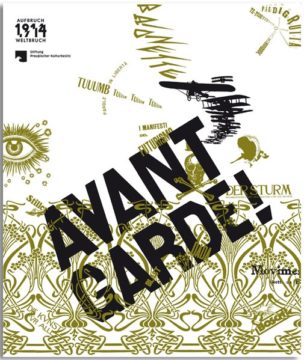Die umfangreiche Publikation thematisiert den künstlerischen Aufbruch in die Moderne vor und während des Ersten Weltkriegs. Anhand zahlreicher Beispiele vor allem der Plakatkunst, der Gebrauchsgrafik und Buchkunst werden programmatische künstlerische Haltungen auf der Suche nach einem neuen Stilverständnis einerseits und einer neuen Hinwendung zum Zeitgemäßen andererseits vorgestellt, darunter ikonische Bildentwürfe von den Beggarstaff Brothers, Jules Chéret, Ludwig Hohlwein, Henri de Toulouse-Lautrec, Lucian Bernhard und anderen.
Vorgestellt wird auch das kommunikative und publizistische Netzwerk der Avantgarden Futurismus und Expressionismus. Die Selbstinszenierung dieser Strömungen als Avantgarde spiegelt sich vor allem in den publizistischen Strategien, die sich nicht nur durch eine bestimmte Rhetorik, sondern durch besondere Textsorten – vor allem Manifeste – auszeichnen.
Das Buch verfolgt die historische Logik der Kunstismen, ihre radikale Konkurrenz und ihre internationale Topografie von der Jahrhundertwende bis zum Ende des Ersten Weltkriegs. Die zahlreichen Textbeiträge führen den Leser in das Labyrinth aus Manifesten, Zeitschriften, Fotografien und Briefen ein und eröffnen überraschende Kontexte und neue Sichtachsen auf die Kunst des 20. Jahrhunderts.
—
The voluminous publication focuses on the artistic breakthrough into modernism before and during the First World War. With the aid of numerous examples, mainly of poster art, commercial art and book art, it introduces programmatic artistic approaches in the search for a new understanding of style on the one hand and a shift towards the contemporary on the other, including iconic designs by the Beggarstaff brothers, Jules Chéret, Ludwig Hohlwein, Henri de Toulouse-Lautrec, Lucian Bernhard and others.
The communicative and journalistic network of the Futurist and expressionist avant-gardes is also presented. The self-promotion of these currents as avant-garde is reflected especially in their journalistic strategies, which are characterized not only by a specific rhetoric but also by special types of text, particularly manifestos.
The book traces the historical logic of the ‚isms,‘ their radical counterparts and their international topography from the turn of the century to the end of the First World War. The numerous texts introduce the reader to the labyrinth of manifestos, magazines, photographs and letters and open up surprising contexts and new vistas on the art of the 20th century.
- Veröffentlicht am Donnerstag 15. Mai 2014 von Verlag Kettler
- ISBN: 9783862063475
- 304 Seiten
- Genre: Hardcover, Kunst, Softcover
